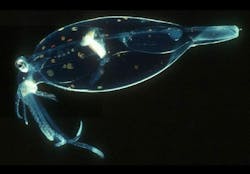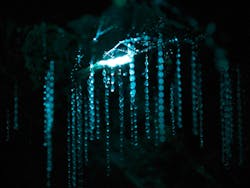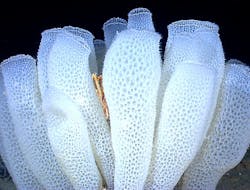What Can We Learn About Fiber Optics that Appear in Nature?
For organisms living in very dark places like caves and trenches, bioluminescence is essential to survival. In the deep ocean, more than 90% of organisms are luminescent. Some use light to create optical illusions that strengthen them as predators, while others may use it reduce their chances of becoming prey. For example, an animal in danger may transmit light throughout its entire body to seem bigger than it is (octopuses do this), while a predator may keep its light confined to seem smaller and more harmless than it is (an angler fish will only brighten its light in search of a mate). In either case, it is common for more complex organisms to alter their brightness in response to stimuli, and to use optical networks that transmit light when they turn it on.
In the caves of New Zealand, the fly larva Arachnocampa luminosa attracts insects by transmitting a blue-green light from its tail through silk strands of its web (shown above). The silk web is lined with a sticky mucus comprised mostly of urea, which becomes an adhesive when mixed with some proteins found in the mucus or silk. Bugs are attracted to the light, and are quickly caught. They become even more entangled in silk when they try to break free.
Scientists investigate the optical and mechanical properties of worm silks to develop waveguides for medical sensors and other applications, according to the Optical Society. They may also investigate doping capabilities with natural silks to change their waveguide properties. Scientists from the University of Queensland in Australia determined the worm's silk makeup through X-ray scattering, Fourier transform infrared spectroscopy, and amino acid analysis (Published on Research Gate). They found the silk contains β-sheet crystallites, contributing to its periodicity to transmit light, and amorpohous or disordered components that contributed to its holding strength (which is really only tough enough to trap small bugs and hold against gravitational creep. But hey, it could still be applicable.)
The next animal FOC scientists can learn about is one of the most primitive on earth—the Venus Flower Basket sea sponge. The sponge has silica spicules that act as waveguides, distributing light throughout its exoskeleton to support its cellular colonies and other creatures living within its barriers. The sponge spicules are made up of lamellar layers connected by organic ligands that surround the fiber, according to a report in a Cornell journal (PDF). The organic ligands not only strengthen the exoskeleton; they insulate its optical cores with a lower refractive-index material for better light transmission through the fibers.
In addition, the spicules can grow to be very long at ambient ocean temperatures, while commercial silica FOCs have to be manufactured at temperatures up to 3,000 °F. And they're even less prone to shattering than manufactured silica FOCs.
Finally, sodium ions within the spicules increase the core’s refractive index for better light transmission through them. With this research, scientists can investigate different methods for doping FOCs with sodium ions, which is already a method used to alter silica FOCs' optical properties and bandgap. And though this research was conducted a few years ago, it could still lead to ideas for integrating biological methods to produce FOCs.
About the Author
Leah Scully
Associate Content Producer
Leah Scully is a graduate of The College of New Jersey. She has a BS degree in Biomedical Engineering with a mechanical specialization. Leah is responsible for Machine Design’s news items that cover industry trends, research, and applied science and engineering, along with product galleries. Visit her on Facebook, or view her profile on LinkedIn.




